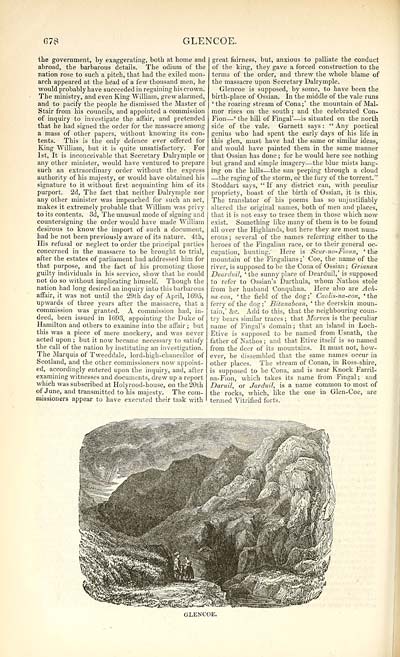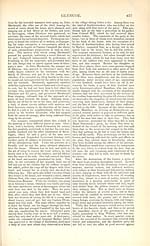Topographical, statistical, and historical gazetteer of Scotland > Volume 1
(776) Page 678
Download files
Complete book:
Individual page:
Thumbnail gallery: Grid view | List view

678
GLENCOE.
the government, by exaggerating, both at home and
abroad, the barbarous details. The odium of the
nation rose to such a pitch, that had the exiled mon-
arch appeared at the head of a few thousand men, he
would probably have succeeded in regaining his crown.
The ministry, and even King William, grew alarmed,
and to pacify the people he dismissed the Master of
Stair from his councils, and appointed a commission
of inquiry to investigate the affair, and pretended
that he had signed the order for the massacre among
a mass of other papers, without knowing its con-
tents. This is the only defence ever offered for
King William, but it is quite unsatisfactory. For
1st, It is inconceivable that Secretary Dalrymple or
any other minister, would have ventured to prepare
such an extraordinary order without the express
authority of his majesty, or would have obtained his
signature to it without first acquainting him of its
purport. 2d, The fact that neither Dalrymple nor
any other minister was impeached for such an act,
makes it extremely probable that William was privy
to its contents. 3d, The unusual mode of signing and
countersigning the order would have made William
desirous to know the import of such a document,
had he not been previously aware of its nature. 4th,
His refusal or neglect to order the principal parties
concerned in the massacre to be brought to trial,
after the estates of parliament had addressed him for
that purpose, and the fact of his promoting those
guilty individuals in his service, show that he could
not do so without implicating himself. Though the
nation had long desired an inquiry into this barbarous
affair, it was not until the 29th day of April, 1695,
upwards of three years after the massacre, that a
commission was granted. A commission had, in-
deed, been issued in 1693, appointing the Duke of
Hamilton and others to examine into the affair ; but
this was a piece of mere mockery, and was never
acted upon ; but it now became necessary to satisfy
the call of the nation by instituting an investigation.
The Marquis of Tweeddale, lord-high-chancellor of
Scotland, and the other commissioners now appoint-
ed, accordingly entered upon the inquiry, and, after
examining witnesses and documents, drew up a report
which was subscribed at Holyrood-house, on the 20th
of June, and transmitted to his majesty. The com-
missioners appear to have executed their task with
great fairness, but, anxious to palliate the conduct
of the king, they gave a forced construction to the
terms of the order, and threw the whole blame of
the massacre upon Secretary Dalrymple.
Glencoe is supposed, by some, to have been the
birth-place of Ossian. In the middle of the vale runs
'the roaring stream of Cona;' the mountain of Mal-
mor rises on the south ; and the celebrated Con-
Fion — ' the hill of Fingal' — is situated on the north
side of the vale. Garnett says : " Any poetical
genius who had spent the early days of his life in
this glen, must have had the same or similar ideas,
and would have painted them in the same manner
that Ossian has done ; for he would here see nothing
but grand and simple imagery — the blue mists hang-
ing on the hills — the sun peeping through a cloud
— the raging of the storm, or the fury of the torrent."
Stoddart says, " If any district can, with peculiar
propriety, boast of the birth of Ossian, it is this.
The translator of his poems has so unjustifiably
altered the original names, both of men and places,
that it is not easy to trace them in those which now
exist. Something like many of them is to be found
all over the Highlands, but here they are most num-
erous ; several of the names referring either to the
heroes of the Fingalian race, or to their general oc-
cupation, hunting." Here is Scur-no-Fionn, ' the
mountain of the Fingalians;' Coe, the name of the
river, is supposed to be the Cona of Ossian ; Grianan
Dearduil, 'the sunny place of Dearduil,' is supposed
to refer to Ossian's Darthula, whom Nathos stole
from her husband Conquhan. Here also are Ac/i-
na-con, 'the field of the dog;' Caolis-na-con, 'the
ferry of the dog;' Bitanahean, ' the deerskin moun-
tain,' &c. Add to this, that the neighbouring coun-
try bears similar traces ; that Morven is the peculiar
name of Fingal's domain ; that an island in Loch-
Etive is supposed to be named from Usnath, the
father of Nathos ; and that Etive itself is so named
from the deer of its mountains. It must not, how-
ever, be dissembled that the same names occur in
other places. The stream of Conan, in Ross-shire,
is supposed to be Cona, and is near Knock Farril-
na-Fion, which takes its name from Fingal; and
Daruil, or Jarduil, is a name common to most of
the rocks, which, like the one in Glen-Coe, are
termed Vitrified forts.
GLENCOE.
GLENCOE.
the government, by exaggerating, both at home and
abroad, the barbarous details. The odium of the
nation rose to such a pitch, that had the exiled mon-
arch appeared at the head of a few thousand men, he
would probably have succeeded in regaining his crown.
The ministry, and even King William, grew alarmed,
and to pacify the people he dismissed the Master of
Stair from his councils, and appointed a commission
of inquiry to investigate the affair, and pretended
that he had signed the order for the massacre among
a mass of other papers, without knowing its con-
tents. This is the only defence ever offered for
King William, but it is quite unsatisfactory. For
1st, It is inconceivable that Secretary Dalrymple or
any other minister, would have ventured to prepare
such an extraordinary order without the express
authority of his majesty, or would have obtained his
signature to it without first acquainting him of its
purport. 2d, The fact that neither Dalrymple nor
any other minister was impeached for such an act,
makes it extremely probable that William was privy
to its contents. 3d, The unusual mode of signing and
countersigning the order would have made William
desirous to know the import of such a document,
had he not been previously aware of its nature. 4th,
His refusal or neglect to order the principal parties
concerned in the massacre to be brought to trial,
after the estates of parliament had addressed him for
that purpose, and the fact of his promoting those
guilty individuals in his service, show that he could
not do so without implicating himself. Though the
nation had long desired an inquiry into this barbarous
affair, it was not until the 29th day of April, 1695,
upwards of three years after the massacre, that a
commission was granted. A commission had, in-
deed, been issued in 1693, appointing the Duke of
Hamilton and others to examine into the affair ; but
this was a piece of mere mockery, and was never
acted upon ; but it now became necessary to satisfy
the call of the nation by instituting an investigation.
The Marquis of Tweeddale, lord-high-chancellor of
Scotland, and the other commissioners now appoint-
ed, accordingly entered upon the inquiry, and, after
examining witnesses and documents, drew up a report
which was subscribed at Holyrood-house, on the 20th
of June, and transmitted to his majesty. The com-
missioners appear to have executed their task with
great fairness, but, anxious to palliate the conduct
of the king, they gave a forced construction to the
terms of the order, and threw the whole blame of
the massacre upon Secretary Dalrymple.
Glencoe is supposed, by some, to have been the
birth-place of Ossian. In the middle of the vale runs
'the roaring stream of Cona;' the mountain of Mal-
mor rises on the south ; and the celebrated Con-
Fion — ' the hill of Fingal' — is situated on the north
side of the vale. Garnett says : " Any poetical
genius who had spent the early days of his life in
this glen, must have had the same or similar ideas,
and would have painted them in the same manner
that Ossian has done ; for he would here see nothing
but grand and simple imagery — the blue mists hang-
ing on the hills — the sun peeping through a cloud
— the raging of the storm, or the fury of the torrent."
Stoddart says, " If any district can, with peculiar
propriety, boast of the birth of Ossian, it is this.
The translator of his poems has so unjustifiably
altered the original names, both of men and places,
that it is not easy to trace them in those which now
exist. Something like many of them is to be found
all over the Highlands, but here they are most num-
erous ; several of the names referring either to the
heroes of the Fingalian race, or to their general oc-
cupation, hunting." Here is Scur-no-Fionn, ' the
mountain of the Fingalians;' Coe, the name of the
river, is supposed to be the Cona of Ossian ; Grianan
Dearduil, 'the sunny place of Dearduil,' is supposed
to refer to Ossian's Darthula, whom Nathos stole
from her husband Conquhan. Here also are Ac/i-
na-con, 'the field of the dog;' Caolis-na-con, 'the
ferry of the dog;' Bitanahean, ' the deerskin moun-
tain,' &c. Add to this, that the neighbouring coun-
try bears similar traces ; that Morven is the peculiar
name of Fingal's domain ; that an island in Loch-
Etive is supposed to be named from Usnath, the
father of Nathos ; and that Etive itself is so named
from the deer of its mountains. It must not, how-
ever, be dissembled that the same names occur in
other places. The stream of Conan, in Ross-shire,
is supposed to be Cona, and is near Knock Farril-
na-Fion, which takes its name from Fingal; and
Daruil, or Jarduil, is a name common to most of
the rocks, which, like the one in Glen-Coe, are
termed Vitrified forts.
GLENCOE.
Set display mode to: Large image | Transcription
Images and transcriptions on this page, including medium image downloads, may be used under the Creative Commons Attribution 4.0 International Licence unless otherwise stated. ![]()
| Gazetteers of Scotland, 1803-1901 > Topographical, statistical, and historical gazetteer of Scotland > Volume 1 > (776) Page 678 |
|---|
| Permanent URL | https://digital.nls.uk/97446858 |
|---|
| Description | Volume first. A-H. |
|---|---|
| Attribution and copyright: |
|

